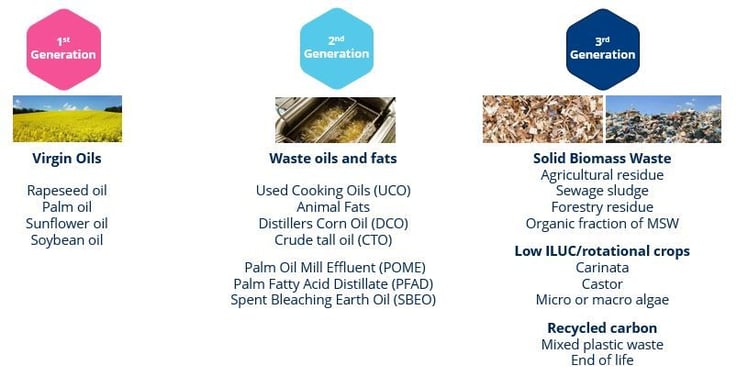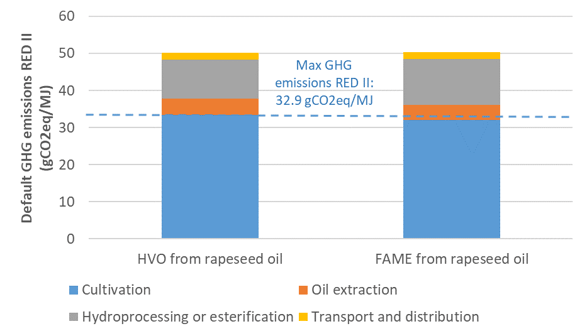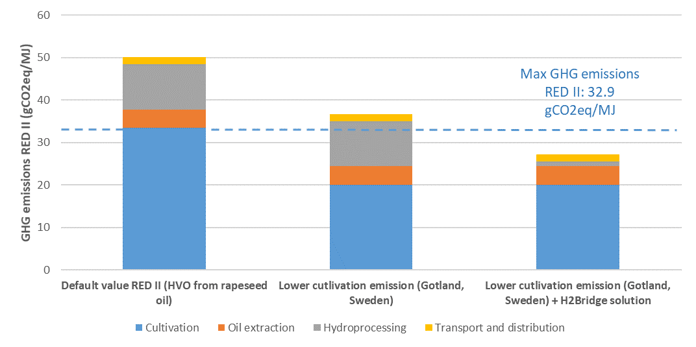Would you like to know more?
Contact us
If you’d like to book a meeting with us to discuss how processing renewables could work for your business, simply fill in the short form below and hit ‘send’.
Close the feedstock generation gap. And lower greenhouse gas emissions
Today three generations of feedstock are available to produce renewable fuels. But not all feedstocks are equal when it comes to meeting the greenhouse gas (GHG) targets. That is one reason why it is essential to select a processing technology that future-proofs your plants' ability to handle all types of feedstocks. And, as an added benefit, it allows you to become independent of changing feedstock prices and potentially restricted supply of first- and second-generation feedstock.

Your choice of feedstock is critical for the GHG emissions of biofuels
GHG emissions can be decreased by choosing a feedstock with low cultivation emissions and using low GHG hydrogen for hydroprocessing. As an example, let us look at the use of rapeseed oil for HVO and FAME.

Figure 1: Default values for emissions from Annex V for rapeseed oil. The blue color depicts the GHG emissions from cultivation, orange is oil extraction, grey is the GHG emissions from the process step from oil to renewable diesel and yellow is the transportation.
The majority of GHG emissions originate from the cultivation of the seeds, and the limit on GHG emission is already reached before reaching the biorefinery site. All processes after cultivation add to the GHG emissions, surpassing the limit for allowed GHG emissions for biofuels.
This figure shows that the GHG emissions are the same irrespective of the process used. We can also clearly see that the main contributors to the GHG emissions are the cultivation followed by the process – whether hydroprocessing or esterification.

Figure 2: Example of GHG emission for HVO produced from rapeseed oil
Figure 2 shows us how it is still impossible to reach the RED II directive limits even with a lower cultivation GHG emission part. However, the challenges to stay below the GHG emission target are multiple. First, it is necessary to process a feedstock with a low cultivation emission, but the process also needs to be optimized to stay below the threshold. The example to the right shows how our H2Bridge™ solution, where a hydrogen unit in combination with a HydroFlex™ hydrotreating unit, will significantly lower the GHG emissions to well below the RED II requirements. This is achieved by minimizing the GHG emissions by using the off-gasses from the hydrotreater for hydrogen generation. Read more here
A circular, sustainable solution
With H2bridge™ and HydroFlex™, you gain a circular solution that will provide you with the ability to produce one of the lowest carbon intensity fuels in the world. You can convert low-value feedstocks to renewable fuels that continuously meet changing specifications and legislative requirements. Add a lower energy consumption during operation, resulting in a lower Carbon Index (CI).
See why Seaboard Energy chose our renewable fuel technology to produce extremely clean renewable diesel from tallow and soybean oil.
Related articles, podcasts and whitepapers

The Fuel for Thought Podcast
The world’s first podcast series about renewables for the refinery industry. We look into some of the most pressing topics in renewable fuels, including new legislation and its impact, certification, feedstocks, and current market drivers and trends.
Process forward
Download the brochure
and see how.
Now you can...become self-sufficient with a circular system replacing external fossil feed.
H2bridgeTM is a circular solution that allows you to replace external fossil feedstocks with renewables LPG or naphtha to produce hydrogen.
Fuel for Thought
Understanding the complexity behind biofuels is not simple, as a wide range of considerations should be carefully understood when embarking on this journey.
Book a meeting today
What if you could future-proof your refinery business against the ever-tightening demands of legislation? Fill in the details below and we’ll contact you to schedule a meeting to discuss how you can make sure you can turn legislative demands into opportunities for growth.